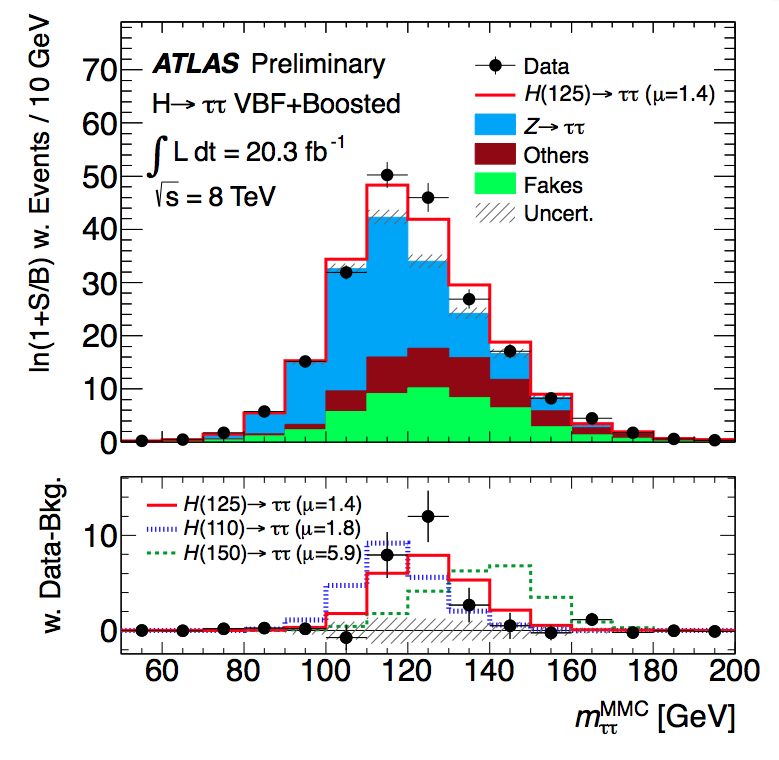Higgs into fermions
26 November 2013 | By

The ATLAS experiment released preliminary results on 26 November 2013 that show evidence, with a significance of 4.1 standard deviations that the Higgs boson decays to two taus, which are fermions. This is exciting news. But what makes this measurement important?
On 4 July 2012, the ATLAS and CMS experiments at CERN announced the discovery of a new particle, which was later confirmed to be a Higgs boson. The Brout-Englert-Higgs mechanism, which helps answer how some elementary particles acquire mass, was postulated almost 50 years ago, but its existence was only directly confirmed by this discovery. For their proposal, with others, of the Brout-Englert-Higgs mechanism, the Nobel Prize in Physics 2013 is awarded to François Englert and Peter Higgs.

For physicists, the discovery meant the beginning of a quest to find out what the new particle was, if it fit in the Standard Model, our current model of Nature in particle physics, or if its properties could point to new physics beyond that model. An important property of the Higgs boson that ATLAS physicists are trying to measure is how it decays.
The Higgs boson lives only for a short time and disintegrates into other particles. The various possibilities of the final states are called decay modes. So far, ATLAS physicists had found evidence that the Higgs boson decays into different types of gauge bosons, the kind of elementary particles that carry forces. The other family of fundamental particles, the fermions, make up matter. The tau (represented by the Greek letter τ) is a fermion and behaves like a very massive electron.
So far, ATLAS had found three different decay modes that provided evidence of the existence of the Higgs boson. The decay modes are: a Higgs boson decaying into two photons (left image below), into two Z bosons (centre below) and into two W bosons (right below). These three modes have something very fundamental in common: they all involve elementary bosons!
In the Standard Model, we can divide fundamental particles into two big families: the bosons (integer spin) and the fermions (half-integer spin). The question was could the new particle decay into fermions too?
The Brout-Englert-Higgs mechanism was first proposed to describe how gauge bosons acquire mass. The Standard Model, however, predicts that fermions also acquire mass in this manner, meaning the Higgs boson could decay directly to bosons or fermions. Other theoretical models forbid the decay to fermions, or allow it, but not necessarily at the same rate as the Standard Model. The new preliminary result from ATLAS shows clear evidence that the Higgs boson indeed does decay to fermions, consistent with the rate predicted by the Standard Model.
Snapshot of traces left by the particles flying through the ATLAS detector. They possibly originate from a Higgs boson decaying into two photons (yellow cones, left), two Z bosons which subsequently decay into four muons (red lines, centre), or two W bosons which subsequently decay into two jets and a muon-neutrino pair.
This important finding, also shown in this CMS result, was made possible through careful analysis of data produced by the LHC during its first run. Only with new data will physicists be able to determine if the compatibility remains or if other new models become viable. Fortunately, the next LHC run, which begins in 2015, is expected to produce several times the existing data sample. In addition, the proton collisions will be at higher energies, producing Higgs bosons at higher rates.
ATLAS' broad physics programme, which includes precision measurements of the Higgs boson, will continue to test the Standard Model. We don't know whether it will stand the test or if we will have to invent new models to describe and understand the interactions of elementary particles.
What we do know is that the years ahead will be very exciting for particle physics as we have found new territory and have only just begun exploring it.






